World War II
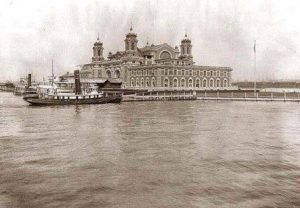 A number of my ancestors came to America during and prior to the years that Ellis Island was the processing center in New York. I have no doubt that some of them came through Ellis Island, but I have not confirmed that. I find many of the names in my tree, but while many of the ancestors I have found came over by way of New York, it would appear that my direct line arrived in America before the immigration center at Ellis Island opened on January 2, 1892. Before that time, immigrants were handled by the individual states where the immigrant first arrived. It is estimated that about 40% of Americans can trace their roots through Ellis Island, so while I see many familiar names, they may or may not be my direct line, and in fact, they might not be related at all.
A number of my ancestors came to America during and prior to the years that Ellis Island was the processing center in New York. I have no doubt that some of them came through Ellis Island, but I have not confirmed that. I find many of the names in my tree, but while many of the ancestors I have found came over by way of New York, it would appear that my direct line arrived in America before the immigration center at Ellis Island opened on January 2, 1892. Before that time, immigrants were handled by the individual states where the immigrant first arrived. It is estimated that about 40% of Americans can trace their roots through Ellis Island, so while I see many familiar names, they may or may not be my direct line, and in fact, they might not be related at all.
Ellis Island is located in New York Harbor off the New Jersey coast and was named for merchant Samuel Ellis, who owned the land in the 1770s. The island was given the nickname, The Gateway to America because more than 12 million immigrants passed through the center since it opened in 1892. On January 2, 1892, 15 year old Annie Moore, from Ireland, became the first person to pass through the newly opened Ellis Island, which President Benjamin Harrison designated as America’s first federal immigration center in 1890. Oddly, not all 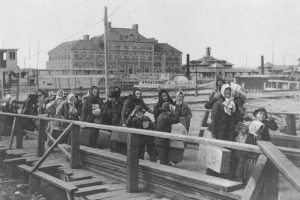 immigrants who sailed into New York had to go through Ellis Island. First and second class passengers were just given a brief shipboard inspection and then disembarked at the piers in New York or New Jersey, where they passed through customs. People in third class, though, were transported to Ellis Island, where they underwent medical and legal inspections to ensure they didn’t have a contagious disease or some condition that would make them a burden to the government. Nevertheless, only two percent of all immigrants were denied entrance into the United States. The peak years of immigration through Ellis Island were from 1892 to 1924. The 3.3 acre island was enlarged by landfill, and by the 1930s, it had reached its current size of 27.5 acres. After the extra size was completed, new buildings were constructed to handle the massive influx of people coming to America for a better life. During it’s busiest year, which was 1907, over 1 million people were processed through Ellis Island.
immigrants who sailed into New York had to go through Ellis Island. First and second class passengers were just given a brief shipboard inspection and then disembarked at the piers in New York or New Jersey, where they passed through customs. People in third class, though, were transported to Ellis Island, where they underwent medical and legal inspections to ensure they didn’t have a contagious disease or some condition that would make them a burden to the government. Nevertheless, only two percent of all immigrants were denied entrance into the United States. The peak years of immigration through Ellis Island were from 1892 to 1924. The 3.3 acre island was enlarged by landfill, and by the 1930s, it had reached its current size of 27.5 acres. After the extra size was completed, new buildings were constructed to handle the massive influx of people coming to America for a better life. During it’s busiest year, which was 1907, over 1 million people were processed through Ellis Island.
When the United States entered into World War I, immigration to the United States decline, most likely because travel anywhere was risky. Ellis Island was used as a detention center for suspected enemies during that time. Following the war, Congress passed quota laws and the Immigration Act of 1924, which sharply reduced the number of newcomers allowed into the country and also enabled immigrants to be processed at United States  consulates abroad. The act also enabled immigrants to be processed at United States consulates abroad, making detention at Ellis Island obsolete. After 1924, Ellis Island switched from a processing center to other purposes, such as a detention and deportation center for illegal immigrants, a hospital for wounded soldiers during World War II and a Coast Guard training center. In November 1954, the last detainee, a Norwegian merchant seaman, was released and Ellis Island officially closed on November 12, 1954. In 1984, Ellis Island underwent a $160 million renovation, the largest historic restoration project in United States history. In September 1990, the Ellis Island Immigration Museum opened to the public and is visited by almost 2 million people each year.
consulates abroad. The act also enabled immigrants to be processed at United States consulates abroad, making detention at Ellis Island obsolete. After 1924, Ellis Island switched from a processing center to other purposes, such as a detention and deportation center for illegal immigrants, a hospital for wounded soldiers during World War II and a Coast Guard training center. In November 1954, the last detainee, a Norwegian merchant seaman, was released and Ellis Island officially closed on November 12, 1954. In 1984, Ellis Island underwent a $160 million renovation, the largest historic restoration project in United States history. In September 1990, the Ellis Island Immigration Museum opened to the public and is visited by almost 2 million people each year.
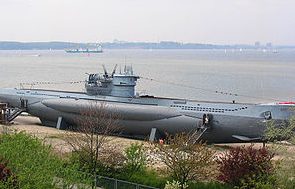 Anytime a soldier goes to war, there is a possibility of that soldier not returning, but some MOS (Military Occupational Specialty) categories were more dangerous than others. The life expectancy of a ball turret gunner in World War II, for instance, was just 12 minutes…yes, that’s right…12 minutes. And these guys didn’t always have a choice as to what job they did. If they were the shortest, they were most likely going to be a ball turret gunner, because of limited space in the ball. Still, while I don’t know the exact number who died, I know it was quite a few. Of course, soldiers on the ground are more at risk than other occupations too. There were the suicide bombers from Japan, who chose to fly their plane right into a ship too, but I think that few occupations were as deadly as that of the U-Boat crew. It wasn’t so much that the occupation was deadly, but rather that every country in the world was after the German U-Boat.
Anytime a soldier goes to war, there is a possibility of that soldier not returning, but some MOS (Military Occupational Specialty) categories were more dangerous than others. The life expectancy of a ball turret gunner in World War II, for instance, was just 12 minutes…yes, that’s right…12 minutes. And these guys didn’t always have a choice as to what job they did. If they were the shortest, they were most likely going to be a ball turret gunner, because of limited space in the ball. Still, while I don’t know the exact number who died, I know it was quite a few. Of course, soldiers on the ground are more at risk than other occupations too. There were the suicide bombers from Japan, who chose to fly their plane right into a ship too, but I think that few occupations were as deadly as that of the U-Boat crew. It wasn’t so much that the occupation was deadly, but rather that every country in the world was after the German U-Boat.

The U-Boat was a German submarine, and they were the best sumbarine the Germans had. There were 40,000 men who were assigned to the German U-Boats during World War II. Of those assigned to the U-Boats, only 10,000 returned. That is a shocking number!! I would never have wanted the Germans to win World War II, but when I think of the soldiers who fought, I’m sure that there were many who disagreed with Hitler, and others who were brainwashed into following him, but they were still soldiers, and people, and they had been given an assignment that was going to most likely get them killed. You see, the German U-Boat was the most feared of all the ships or submarines during World War II. They had a code system that was hard to crack, and they were sinking the Allies ships. They had to go. Once the Allies figured out their code, they could no longer hide. The U-Boats began dropping like flies, and with them… their crews, of course.
their crews, of course.
The U-Boats ran on battery power when they were submerged, and that didn’t last very long. So they were required to be a surface vessel most of the time, operating on their diesel engines. I don’t think that contributed to the U-Boat becoming a target, because as long as their whereabouts was coded, they were relatively safe. Once that safety net was gone, they were in a lot of trouble, as has been proven by the number of casualties. The fate of the crews of the U-Boats was not a good one, and those 30,000 men paid the final price, once that safety net was gone.
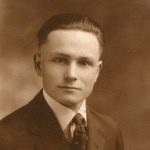
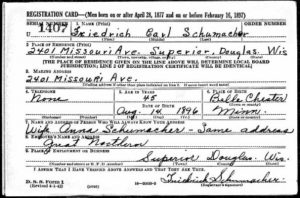 As I have researched my family history, I have come across a number of World War II draft registration cards for older men. I found that to be very strange. It seemed odd to me that men who were technically too old to serve in battle…at least by military standards, were required to register, and quite possibly be drafted into the war. Some of these men weren’t so very old by today’s standards, such as my great uncle, Friedrich Schumacher, who was 45 at the time of his World War II draft registration, or my grandfather, George Byer, who was 48 at the time of his World War II draft registration, but others, such as my grandfather, Allen Luther Spencer, who was 63 at the time of his World War II registration, were much older. These draft registrations really surprised me. Why would our government need to have these men register?
As I have researched my family history, I have come across a number of World War II draft registration cards for older men. I found that to be very strange. It seemed odd to me that men who were technically too old to serve in battle…at least by military standards, were required to register, and quite possibly be drafted into the war. Some of these men weren’t so very old by today’s standards, such as my great uncle, Friedrich Schumacher, who was 45 at the time of his World War II draft registration, or my grandfather, George Byer, who was 48 at the time of his World War II draft registration, but others, such as my grandfather, Allen Luther Spencer, who was 63 at the time of his World War II registration, were much older. These draft registrations really surprised me. Why would our government need to have these men register?
My curious mind had to know the answer to that question, and so I began to look online to see if anything was said about it at all. Well, it only took looking at three websites to find the answer. I wondered if they were just desperate for soldiers, because as most people know, World War II saw the most American war deaths at 405,399, than any other war in American history. Nevertheless, that was not the reason for the Fourth 
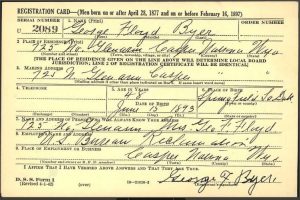 Registration, which became known as the Old Man’s Draft, because it targeted men between the ages of 45-64 years of age. No, these men were not going to be soldiers who were require to go into battle. This draft registration was intended to provide the government with a register of manpower…men who might be eligible for national service. Help was needed on the home front, and this was a way to ensure that the manpower needed was available. After all, if you are drafted, you are required to serve.
Registration, which became known as the Old Man’s Draft, because it targeted men between the ages of 45-64 years of age. No, these men were not going to be soldiers who were require to go into battle. This draft registration was intended to provide the government with a register of manpower…men who might be eligible for national service. Help was needed on the home front, and this was a way to ensure that the manpower needed was available. After all, if you are drafted, you are required to serve.
Registration of the Old Man’s Draft began on April 27, 1942 at local draft boards around the country, and like the patriotic citizens they were, my great uncle, and my grandfathers, along with many, many other older men, went to register. The lines were long when the men went in to register, according to the Poughkeepsie Journal, but the biggest regret that was heard among the men waiting there was…that they were too old to fight!! Seriously!! There were no complaints about standing for hours in line, or complaints about having to register at all…just that they would not see battle. These were not warmongers, but rather patriots who wanted to help in whatever way they could, and now Uncle Sam was telling them that their contribution was important. It felt 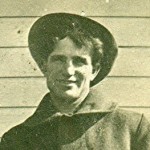
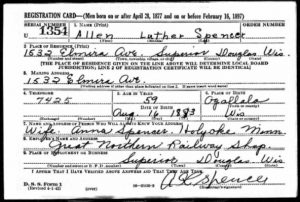 amazing to these men. They were needed!! The biggest complication was that some of the men couldn’t read or write, and some had forgotten things like addresses, telephone numbers, or dates (including the year of birth, which is evident on my grandfather’s card in that his year of birth was listed as 1883, but he was born in 1879). Nevertheless, these men were hopeful that somehow they could be useful in the war effort. I find that completely amazing…especially in light of the lack of patriotism so often seen these days.
amazing to these men. They were needed!! The biggest complication was that some of the men couldn’t read or write, and some had forgotten things like addresses, telephone numbers, or dates (including the year of birth, which is evident on my grandfather’s card in that his year of birth was listed as 1883, but he was born in 1879). Nevertheless, these men were hopeful that somehow they could be useful in the war effort. I find that completely amazing…especially in light of the lack of patriotism so often seen these days.
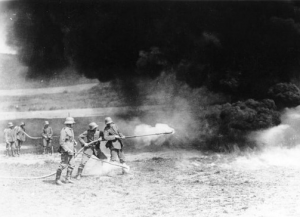 Over the centuries of life on Earth, there have been numerous wars, and numerous weapons of warfare. Yet, few could bring fear to the heart of an infantryman quicker than the Flammenwerfer. Developed by the Germans during World War I, the Flammenwerfer…or Flamethrower, in English…once lit could throw a steady stream of flames 20 to 30 feet in front of it. For the men on the ground, this meant one of two things. They could run…abandoning the relative safety of their foxhole, usually with the result of being shot down by the enemy, or they could stand their ground and be incinerated. It wasn’t much of a choice really, and most ran in the hope of escaping the machine gun fire that would undoubtedly follow the flamethrower. It was a situation of instant death…no matter which choice a soldier made…not to mention the fact that every fiber of a soldier’s being and training told them to stand their ground. This weapon took much of it toll on the soldier’s sense of bravery.
Over the centuries of life on Earth, there have been numerous wars, and numerous weapons of warfare. Yet, few could bring fear to the heart of an infantryman quicker than the Flammenwerfer. Developed by the Germans during World War I, the Flammenwerfer…or Flamethrower, in English…once lit could throw a steady stream of flames 20 to 30 feet in front of it. For the men on the ground, this meant one of two things. They could run…abandoning the relative safety of their foxhole, usually with the result of being shot down by the enemy, or they could stand their ground and be incinerated. It wasn’t much of a choice really, and most ran in the hope of escaping the machine gun fire that would undoubtedly follow the flamethrower. It was a situation of instant death…no matter which choice a soldier made…not to mention the fact that every fiber of a soldier’s being and training told them to stand their ground. This weapon took much of it toll on the soldier’s sense of bravery.
The Flammenwerfer was developed in 1915 by the Germans, and first used in battle against the Allied forces on this day, July 30, 1915 at the Battle of Hooge. Eleven days before that battle, British infantry had captured the German occupied village of Hooge, located near Ypres in Belgium, by detonating a large mine. Using the flamethrowers, along with machine guns, trench mortars and hand grenades, the Germans got their positions 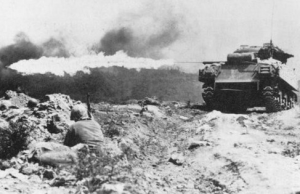 back on July 30, 1915. They broke through enemy front lines with ease, pushing the British forces back to their second trench. Only a few men were lost to actual burns, but a British officer was heard to explain that the weapons had a great demoralizing effect, and when added to the assault of the other powerful weapons, they proved mercilessly efficient at Hooge. I suppose that is true. I can think of few things more demoralizing for a soldier than running from your position in fear. Soldiers don’t take kindly to fear…or running away.
back on July 30, 1915. They broke through enemy front lines with ease, pushing the British forces back to their second trench. Only a few men were lost to actual burns, but a British officer was heard to explain that the weapons had a great demoralizing effect, and when added to the assault of the other powerful weapons, they proved mercilessly efficient at Hooge. I suppose that is true. I can think of few things more demoralizing for a soldier than running from your position in fear. Soldiers don’t take kindly to fear…or running away.
During World War I, the Germans were the only ones to use such a weapon, and not because it was difficult to make. So, why didn’t the Allies us it too? It was one of the great puzzles that emerged from World War I. Why? The British made three attempts with larger, more unwieldy prototypes: the smallest one was equal in size to the German Grof, which the enemy had almost abandoned by 1916. The French were more persistent, and by 1918 had at least seven companies trained in using flamethrowers, and still the use of the weapon never progressed to the same level as that of the German army.
By World War II, however, the flamethrower was the most dramatic hand weapon used by any Army and the most effective for its purpose. But it was during the 20th century that engineers and scientists placed flames 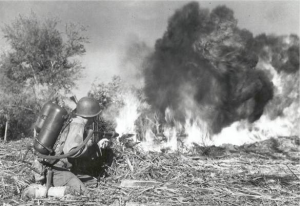 under advanced technological control in an effort to make flamethrowers portable, reliable and reasonably safe…for the user anyway. Prior to that the words “friendly fire” had a second meaning in that flamethrowers could kill the operator while he was doing his best to kill the enemy with it. The result of this new technology was a device with as much psychological impact as it’s lethality impact. That was the chief reason why the United States, Great Britain and other world powers used the flamethrower from World War I through the Vietnam War. Even today, Russia still has flamethrowers in its inventory. I guess it is an important weapon, but for most of us, I think that just the thought of using it on someone would make us seriously ill.
under advanced technological control in an effort to make flamethrowers portable, reliable and reasonably safe…for the user anyway. Prior to that the words “friendly fire” had a second meaning in that flamethrowers could kill the operator while he was doing his best to kill the enemy with it. The result of this new technology was a device with as much psychological impact as it’s lethality impact. That was the chief reason why the United States, Great Britain and other world powers used the flamethrower from World War I through the Vietnam War. Even today, Russia still has flamethrowers in its inventory. I guess it is an important weapon, but for most of us, I think that just the thought of using it on someone would make us seriously ill.

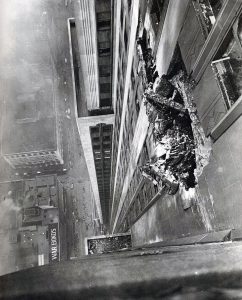 World War II saw the shooting down of more of our military planes that most of us want to think about. We saw the loss by planes being shot down, but also transport planes lost, and planes lost in training accidents. The loss was felt deeply. I realize that accidents are a fact of life and during wartime they are probably more likely to happen than other times, but some accidents just have a bigger impact on our emotions than others. Such was the case of the accident of July 28, 1945.
World War II saw the shooting down of more of our military planes that most of us want to think about. We saw the loss by planes being shot down, but also transport planes lost, and planes lost in training accidents. The loss was felt deeply. I realize that accidents are a fact of life and during wartime they are probably more likely to happen than other times, but some accidents just have a bigger impact on our emotions than others. Such was the case of the accident of July 28, 1945.
That morning, the skies over New York City were filled with heavy fog. A B-52 Mitchell Bomber with two pilots and one passenger aboard, en route from New Bedford, Massachusetts, to LaGuardia Airport in New York City, was diverted because the fog was so thick. As it came into the metropolitan area on that Saturday morning, air-traffic controllers instructed the plane to fly to Newark Airport instead.
The new flight plan took the plane over Manhattan. The pilots were warned that the Empire State Building, the tallest building in the city at that time, was not visible. In an effort to gain better visibility, the pilot of the bomber was flying relatively slowly and quite low. As the plane came in straight at the Chrysler Building in midtown, it swerved to avoid the collision, thereby setting it in a collision path with the Empire State Building, hitting the building near the 79th floor. The fuel tanks exploded, filling the building with flames down to the 75th floor, and out of the building at the impact site. One engine from the plane went straight through the building and landed in a penthouse apartment across the street. Other plane parts were embedded in and on top of nearby buildings. The other engine snapped an elevator cable while at least one woman was riding in the elevator car. The emergency auto brake saved the woman from crashing to the bottom, but the engine fell down the shaft and landed on top of it. Thankfully, the rescuers pulled the woman from the elevator, thereby saving her life.
July 28th was a Saturday that year, so there were fewer people in the building. The loss of life in the Empire State Building was only 11 people, but death came by way of horrific burns from the jet fuel, or being thrown from the building. The 11 people killed were all workers from the War Relief Services Department of the National Catholic Welfare Conference…the office that the plane crashed into on that fateful day. The other three deaths were the two pilots and their passenger. The crash left an 18 by 20 foot hole in the side of the Empire State Building. The building itself, stood however, because, this plane was nowhere near the size of the planes 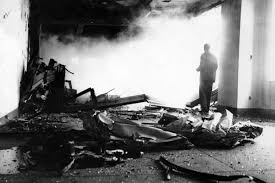
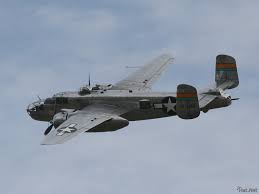 that took down the World Trade Center in Manhattan on Sept 11, 2001, an event that probably seemed eerily similar to those who were alive and living in New York City on July 28, 1945. The crash caused one million dollars in damage at that time, which would equate to about 10.5 million these days. For many people this was an event, much like 9-11 that would never be forgotten, even though it was not a terrorist attack, but rather a tragic accident.
that took down the World Trade Center in Manhattan on Sept 11, 2001, an event that probably seemed eerily similar to those who were alive and living in New York City on July 28, 1945. The crash caused one million dollars in damage at that time, which would equate to about 10.5 million these days. For many people this was an event, much like 9-11 that would never be forgotten, even though it was not a terrorist attack, but rather a tragic accident.
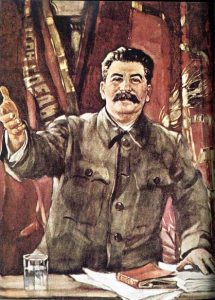 Imagine being in a country where being afraid is a crime. I’m sure you are wondering how that is possible…in any country, but I assure you, it is. That was the case on this day, July 27, 1943 in Russia. Joseph Stalin was the premier and dictator of Russia at that time in history, and Adolf Hitler was the dictator of Germany. The Germans were advancing into Russian territory, and Stalin was determined to stop them, no matter the cost.
Imagine being in a country where being afraid is a crime. I’m sure you are wondering how that is possible…in any country, but I assure you, it is. That was the case on this day, July 27, 1943 in Russia. Joseph Stalin was the premier and dictator of Russia at that time in history, and Adolf Hitler was the dictator of Germany. The Germans were advancing into Russian territory, and Stalin was determined to stop them, no matter the cost.
Hitler had become quite bold because of the early successes against Russia in his goal of taking Leningrad and Stalingrad. The attack on Stalingrad proved, however, that the Russians had superior manpower and it was an enormous drain on German resources and troop strength. The Germans were repulsed by a fierce Soviet fighting force, that had been reinforced with more men and materials. Hitler made the decision to turn his sights to Leningrad.
Stalin needed to make sure his force wouldn’t back down…no matter what happened. The motivation to stand 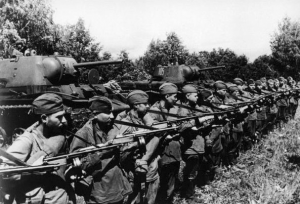 their ground needed to apply to both officers and civilians alike, or he was sure that Leningrad would be lost. That was when Stalin decided to put order number 227 into effect. So, what was order number 227? The order declared, “Panic makers and cowards must be liquidated on the spot. Not one step backward without orders from higher headquarters! Commanders…who abandon a position without an order from higher headquarters are traitors to the Fatherland.” Basically the order said that no one…not one person would be a coward. The order became known as the “not one step backward” order. The military personnel, as well as civilians were forced to fight for their city.
their ground needed to apply to both officers and civilians alike, or he was sure that Leningrad would be lost. That was when Stalin decided to put order number 227 into effect. So, what was order number 227? The order declared, “Panic makers and cowards must be liquidated on the spot. Not one step backward without orders from higher headquarters! Commanders…who abandon a position without an order from higher headquarters are traitors to the Fatherland.” Basically the order said that no one…not one person would be a coward. The order became known as the “not one step backward” order. The military personnel, as well as civilians were forced to fight for their city.
I think I can understand what Stalin was doing, but it seems such a drastic measure to take. Still, while some  people might fight the enemy to the end, others might decide that their city wasn’t worth their life. If the penalty for backing off was instant liquidation, then standing and fighting became the only way to have a chance at life. In my opinion, that as far as ways to gain loyalty goes, this was not the best of plans, but then forced loyalty seldom is. Still, one must never underestimate the love a patriot feels for their country. The “not one step backward” order was virtually unnecessary, in that on the day the order was issued, the Russian peasants and other supporters in the Leningrad region killed a German official, Adolf Beck, whose job was to send agricultural products from occupied Russia to Germany and to German troops. The Russian patriots also set fire to the granaries and barns in which the stash of agricultural products was stored before transport. A partisan pamphlet issued an order of its own: “Russians! Destroy the German landowners. Drive the Germans from the land of the Soviets!” I guess Stalin had misjudged his peoples’ loyalty.
people might fight the enemy to the end, others might decide that their city wasn’t worth their life. If the penalty for backing off was instant liquidation, then standing and fighting became the only way to have a chance at life. In my opinion, that as far as ways to gain loyalty goes, this was not the best of plans, but then forced loyalty seldom is. Still, one must never underestimate the love a patriot feels for their country. The “not one step backward” order was virtually unnecessary, in that on the day the order was issued, the Russian peasants and other supporters in the Leningrad region killed a German official, Adolf Beck, whose job was to send agricultural products from occupied Russia to Germany and to German troops. The Russian patriots also set fire to the granaries and barns in which the stash of agricultural products was stored before transport. A partisan pamphlet issued an order of its own: “Russians! Destroy the German landowners. Drive the Germans from the land of the Soviets!” I guess Stalin had misjudged his peoples’ loyalty.
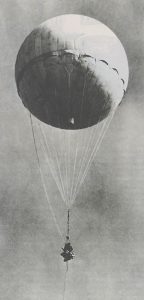 I suppose a true World War II history buff might know about some of the strange war stories there are out there, and I rather thought I was becoming a World War II history buff, but I had never heard of the Japanese Balloon Bombs. I can’t imagine how a nation could send a random bomb over another nation, not knowing where it will land, or who it will kill…but then, the evil we have seen in the 21st century has proven to be very much the same. I guess there really is nothing new under the sun. Where evil exists, horrible things happen. Such was the case with the Japanese Balloon Bombs. The Japanese were an evil nation at that time, and they didn’t care who they hurt. in 1945, a Japanese Balloon Bomb landed in rural Oregon, ad killed six people . As it turns out, these were the only World War II combat casualties within the continental 48 states. Apparently, the accuracy of the balloon bombs left something to be desired…thankfully.
I suppose a true World War II history buff might know about some of the strange war stories there are out there, and I rather thought I was becoming a World War II history buff, but I had never heard of the Japanese Balloon Bombs. I can’t imagine how a nation could send a random bomb over another nation, not knowing where it will land, or who it will kill…but then, the evil we have seen in the 21st century has proven to be very much the same. I guess there really is nothing new under the sun. Where evil exists, horrible things happen. Such was the case with the Japanese Balloon Bombs. The Japanese were an evil nation at that time, and they didn’t care who they hurt. in 1945, a Japanese Balloon Bomb landed in rural Oregon, ad killed six people . As it turns out, these were the only World War II combat casualties within the continental 48 states. Apparently, the accuracy of the balloon bombs left something to be desired…thankfully.
The idea of a balloon bomb was to send in a bomb that was silent. The problem is that balloons are hard to control. They go with the flow of the wind currents, so you don’t know where they will land. Then again, the Japanese were at war with the world, so they really didn’t care where the balloons would land. The six people who were killed by the Fu-Go or fire-balloon bomb, as they were called, were a Sunday School teacher Elyse Mitchell (and her unborn child), her 13 and 14 year old students, Jay Gifford, Edward Engen, Sherman Shoemaker, Dick Patzke, all of whom were killed instantly, when the bomb exploded. Dick Patzke’s sister, Joan was severely burned, and died moments later. The group had stopped for a moment, because Elyse Mitchell was feeling ill, and while her husband, Reverend Archie Mitchell talked with construction workers in the area, the six victims went to investigate a balloon they saw. It would prove to be a fatal mistake. The group had been going on a Saturday afternoon picnic near Klamath Falls, Oregon. They had only walked about 100 yards from the car. One of the road-crew workers, Richard Barnhouse, said “There was a terrible explosion. Twigs flew through the air, pine needles began to fall, dead branches and dust, and dead logs went up.”
Made of rubberized silk or paper, each balloon was about 33 feet in diameter. Barometer-operated valves released hydrogen if the balloon gained too much altitude or dropped sandbags if it flew too low. The balloons were filled with 19,000 cubic feet of hydrogen and the jet stream drew them eastward. They were designed to travel across the Pacific to North America, where they would drop incendiary devices or anti-personnel explosives. I would think the hydrogen alone would make a horrible bomb, but attached to the  balloon was the actual bomb. The Japanese released an estimated 9,000 fire balloons during the last months of World War II. At least 342 reached the United States, with some drifting as far as Nebraska. Some were shot down. Some caused minor damage when they landed, but no injuries. One hit a power line and blacked out the nuclear-weapons plant at Hanford, Washington. But the only known casualties from the 9,000 balloons…and the only combat deaths from any cause on the U S mainland were the five kids and their Sunday school teacher going to a picnic. What a valiant victory for the Japanese that was.
balloon was the actual bomb. The Japanese released an estimated 9,000 fire balloons during the last months of World War II. At least 342 reached the United States, with some drifting as far as Nebraska. Some were shot down. Some caused minor damage when they landed, but no injuries. One hit a power line and blacked out the nuclear-weapons plant at Hanford, Washington. But the only known casualties from the 9,000 balloons…and the only combat deaths from any cause on the U S mainland were the five kids and their Sunday school teacher going to a picnic. What a valiant victory for the Japanese that was.

 Years ago, I watched a movie called Night Crossing, which came out in 1982. The movie was based on a true story about two families trapped in East Germany in 1979. The only way they could be free was to escape to the west. Over the years during which Germany was divided, and basically locked down. At first the people felt panic. Many of them had family on the other side, and no way to get to them. It was horrible. Escape attempts while not constant, were met with severe repercussions. I’m sure many people thought that they would always be prisoners in East Germany. Since today marks, the 68th anniversary of the ill fated Soviet blockade of their section of Germany following World War II, I was reminded of the movie I had seen.
Years ago, I watched a movie called Night Crossing, which came out in 1982. The movie was based on a true story about two families trapped in East Germany in 1979. The only way they could be free was to escape to the west. Over the years during which Germany was divided, and basically locked down. At first the people felt panic. Many of them had family on the other side, and no way to get to them. It was horrible. Escape attempts while not constant, were met with severe repercussions. I’m sure many people thought that they would always be prisoners in East Germany. Since today marks, the 68th anniversary of the ill fated Soviet blockade of their section of Germany following World War II, I was reminded of the movie I had seen.
I was so surprised about the elaborate lengths the family had to go to, in order to buy the materials needed to make a hot air balloon, with out arousing suspicions. To buy enough of the silk for the balloon, they had to go to several different locations, and tell the clerks that they were building tents for a scout group to use to go camping. I couldn’t imagine having to lie to a store clerk in order to purchase material, but then I have never lived anywhere, but in a free society, where the individual person had the right to do pretty much what they pleased. That was something that some of the people of that time, in East Germany, had never known.
While the situation was traumatic, I found myself…somehow fascinated with the process, the planning, the forethought, and the tenacity of these families. I found myself rooting for them every step of the way. Rooting for them wasn’t the thing that surprised me, however. It really was how interested I was in all the strategizing, and yes, the danger of it all. I don’t suppose the event felt anything like that to them, however. For them, this was life and death, because if they were caught, they would be killed. They would have one chance to escape, 
 and one chance only. And they still had to make the crossing, and the landing, without getting caught up in the barbed wire fencing, or landing on a fence somewhere. The whole event, while an exciting story for me, was probably an event that they could not wait to put behind them…and I don’t blame them there.
and one chance only. And they still had to make the crossing, and the landing, without getting caught up in the barbed wire fencing, or landing on a fence somewhere. The whole event, while an exciting story for me, was probably an event that they could not wait to put behind them…and I don’t blame them there.
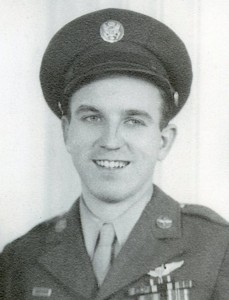 It’s hard for me to think about D-Day, without wondering what things were going through my dad, Allen Spencer’s mind on that day. Each branch of the military had their own part to play and each was in much danger. I suppose it’s possible that the men on the ground were in the most danger, but in reality, anyone who was involved that day faced grave danger. Soldiers could be shot and killed, ships could be sunk, and planes could be shot down. No matter how the attack came, death was often the result, and in battle it was inevitable.
It’s hard for me to think about D-Day, without wondering what things were going through my dad, Allen Spencer’s mind on that day. Each branch of the military had their own part to play and each was in much danger. I suppose it’s possible that the men on the ground were in the most danger, but in reality, anyone who was involved that day faced grave danger. Soldiers could be shot and killed, ships could be sunk, and planes could be shot down. No matter how the attack came, death was often the result, and in battle it was inevitable.
My dad was a young man of just 20 years. That is the age of my two oldest grandchildren, and I simply cannot imagine either of them being in that position. Of course, they could handle it, because twenty year olds have been fighting wars for as long as wars have been fought. It is me, and my mind, that can’t wrap itself around the idea of them being in an airplane providing air support over a battlefield. For my dad, every mission held an adrenalin rush, a degree of excitement, and a large degree of dread, mixed with the need to push back fear. Flying in the B-17G Bomber was an exciting thing for him, but unfortunately it had to  be mixed with the reality of the fact that those bombs were killing people…even if they were the enemy. They often had no say in the matter, they were an enemy of the Allied Forces simply because they lived in the country they did.
be mixed with the reality of the fact that those bombs were killing people…even if they were the enemy. They often had no say in the matter, they were an enemy of the Allied Forces simply because they lived in the country they did.
The air war was vastly different from the ground war, but that didn’t make either more of less dangerous. The Luftwaffe was not widely used on D-Day, but did come racing in over the following days. The weather was bad that first day, and that was definitely to the advantage of the Allied troops. Nevertheless, there were German forces involved, and without air support, they could not have pulled off the victory they did at Normandy. The planes that were there to provide air support, were basically magnets for the  Luftwaffe, and any other enemy forces on the ground. Flying over Normandy was not a task to be taken lightly. Their job was to keep the bombers, tanks, and other soldiers off of the ground troops. The men risked their lives every second that they were in the air. The men on the ground were so vulnerable, and it was imperative that they have good air cover to keep as much enemy fire off of them as possible. It was very clear that without the air support, D-Day would not have been possible.
Luftwaffe, and any other enemy forces on the ground. Flying over Normandy was not a task to be taken lightly. Their job was to keep the bombers, tanks, and other soldiers off of the ground troops. The men risked their lives every second that they were in the air. The men on the ground were so vulnerable, and it was imperative that they have good air cover to keep as much enemy fire off of them as possible. It was very clear that without the air support, D-Day would not have been possible.
I am very proud of the part my dad played in D-Day, as I am of men like my Uncle Jim Wolfe, who was one of those men on the ground on that fateful day. Their job was a very dangerous one, and many of them would not see the sun set that night, but they had a job to do, and so they went out to battle for the freedom of those who were oppressed by the evil that was Hitler. It is a battle we will never forget, nor will we forget the men who fought there, especially those who gave all.
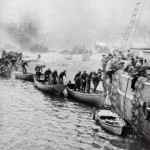 Not many disastrous wartime defeats could be declared a miraculous success, but in May of 1940, with the Germans advancing quickly toward Dunkirk the French, British, and Canadian troops were trapped between the German forces, and the English Channel. This situation was far more that a disastrous defeat, it was about to get catastrophic, because there appeared to be no way to get the Allied troops out of the way of the German forces, and the Allies were looking at the loss of thousands of soldiers, if something wasn’t done…and done quickly!!
Not many disastrous wartime defeats could be declared a miraculous success, but in May of 1940, with the Germans advancing quickly toward Dunkirk the French, British, and Canadian troops were trapped between the German forces, and the English Channel. This situation was far more that a disastrous defeat, it was about to get catastrophic, because there appeared to be no way to get the Allied troops out of the way of the German forces, and the Allies were looking at the loss of thousands of soldiers, if something wasn’t done…and done quickly!!
It was at this point that my 15th cousin 0nce removed, Winston Spencer-Churchill showed the world what a great master strategist he really was. He had warned the Allies that “the whole root, the core, and brain of the British Army” was stranded and likely to die in Dunkirk, if they didn’t come up with a way to evacuate them. A plan was devised, and given the code name, Operation Dynamo. This plan was really a God-given way of escape, where their seemed to be no way. In fact, Churchill  called it “a miracle of deliverance.” And so it was.
called it “a miracle of deliverance.” And so it was.
The plan used every available “ship”…right down to the smallest lifeboat. These vessels…thousands of them, many of which were manned by civilian volunteers, and each of them knew the danger they were putting themselves and their vessels in, but they bravely made the decision to participate anyway. On this day, May 26, 1940, at 19:00 hours, Vice Admiral Ramsey was given the orders and Operation Dynamo commenced. The order was given to proceed, amid information that Boulogne and Calais had been captured. This meant that the only port available was Dunkirk. Ramsey estimated that only 45,000 troops could be rescued. Lord John Galt had ordered the troops to retreat to the sea. As the Belgian army was defeated, King Leopold asked the Germans for an armistice. This dragged out the negotiations, and bought the Allies 24 hours to get their troops out.
The rescue was slow and, in fact took days. The weather prevented the Luftwaffe from attacking for a time, but that didn’t last long. Within a matter of days the weather cleatred and the Germans set out to try to stop the  rescue that they had not realized was of the magnitude it was. From their attack, several ships wer sunk, but that still didn’t stop the seccess of the operation. By the time the last boat left Dunkirk harbor, about 338,226 soldiers (198,229 British and 139,997 French) were evacuated by a fleet of 860 boats.
rescue that they had not realized was of the magnitude it was. From their attack, several ships wer sunk, but that still didn’t stop the seccess of the operation. By the time the last boat left Dunkirk harbor, about 338,226 soldiers (198,229 British and 139,997 French) were evacuated by a fleet of 860 boats.
The evacuation was dubbed Operation Dynamo, because during World War One, Dover Castle was powered with electricity by a dynamo located beneath the castle. The castle was used as naval headquarters during World War Two, and the dynamo room is where British Vice-Admiral Bertram Ramsay planned the Dunkirk rescue mission. It is also the place where Ramsay briefed Churchill while rescue efforts were underway.

